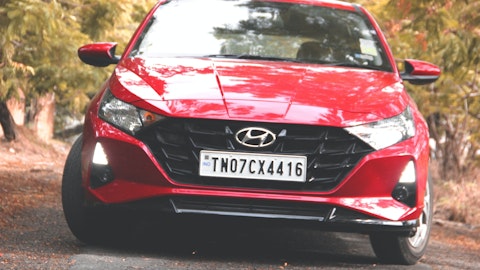Patrick McCann: It’s a little bit tricky, Colin. I don’t want to boggy down in this call. But the contracts we have with Steyr, not only with Fisker, but all the contracts, they’re a little bit more complicated than you’d see in the normal industry where it’s no volume requirement appeal. These have more — much more complex contracts where you have fixed cost recoveries depending on fixed costs incurred and then assumptions on original volume projections versus actual. So there is a true-up mechanism. So it’s not an easy answer. That’s why you don’t see CVAs margins move around as revenues increase or decrease like our other segments.
Colin Langan: Okay. And just a quick one. Equity income, I think it was only $3 million in the quarter, but the guidance is like $120 million, $150 million for next year. What was the unusual issue in Q4 and the confidence in getting back to those higher numbers?
Patrick McCann: Yes. I think in Q4, there was a — I would say there was — one was operational, which was we had a mix issue within one joint venture being products that drove. So even though you don’t see it even though the revenue within the joint venture was consistent, we had negative product mix and then you had margin negative headwinds on that. We also had some commercial items that we had expected to collect in the fourth quarter that have been pushed into 2024. And then the most significant piece of it, it was — when we did the — we — but when the joint venture partner did a finalization of all the deferred tax assets for US GAAP purposes, there was an adjustment to our final tax numbers. And because equity income on an after-tax basis, that flows through that line.
Colin Langan: Okay. Got it. Thanks for taking my question.
Patrick McCann: All right. Thanks.
Operator: Our next question is from the line of Joseph Spak with UBS Securities. Please go ahead.
Joseph Spak: Thanks. Good morning everyone. Just quickly back on the customer on the CapEx. Is it possible to sort of indicate what product line it is? Or is it across product lines? And is some of that associated revenue already considered in the ’26 guide?
Swamy Kotagiri: Yes. I think the associated revenue is included for sure. I don’t think we can get into the specifics of the product line credit, but it’s towards — I would say.
Joseph Spak: Okay. Maybe to follow on from some of Rod’s question before. If we look at power and vision. And if I’m looking at the ’24 to ’26, like the incremental margins there are significantly stronger, which I imagine is in part driven by the breakthrough and the Active Safety business. But is there anything else sort of driving that? Are synergies maybe coming in maybe better than that $70 million that you sort of originally targeting? Or anything else sort of driving the strong incrementals there?
Swamy Kotagiri: So just part of it is the synergies, but I talk about $70 million run rate by end of ’25. So seem to be a good track to that. So we’ll hit ’24 half of that run rate going forward. That’s one of it. The other one is also the sales revenue coming, right, and keeping R&D costs and engineering spend constant. If you look at the trajectory that we talked about going into ’25, ’26, that also contributes to the margin expansion compared to where we were in ’23.
Joseph Spak: Okay. If I could —
Patrick McCann: So other thing to add to that is when Swamy refers to the sales growth, and we’re starting to see that inflection point in the megatrends and most of the megatrends are in the PNB group. Swamy is also referring to unconsolidated sales. So when you look at our equity income, we’re seeing a benefit come through equity income. And as equity income to sales, we’re seeing about a 15 basis point benefit just even out of equity income on its own.
Joseph Spak: Okay. That’s super helpful. Maybe just one more quick one. If I’m not mistaken, I think you did push out your megatrend breakeven by a year. And I just want to make sure, is that basically solely related to some of the slower EV development you’ve talked about? Or is there anything else going on there?
Swamy Kotagiri: So it’s purely related to the volume and program programs being pushed out, Joseph, nothing different. Like I said again, we’ll continue to look at it from R&D and spend and all that stuff to see what opportunities we have to bring it back.
Joseph Spak: Okay. Thank you very much.
Operator: Our final question is from the line of Michael Glen with Raymond James. Please go ahead.
Michael Glen: Thanks for getting me in. The $900 million of megatrend spending that sits as part of the $1.2 billion. Are you able to give kind of a rough breakdown of what those buckets consist of across the segments?
Swamy Kotagiri: Yes. Good morning, Michael. I think typically, when we do that, there is some, call it, cross synergies going between whether it’s software or whether some other aspects of it. But predominantly, it is in the electrification and the ADAS area. It will be difficult to break it down exactly what those are. There is some overlapping areas that we do spend to keep the synergies where we need to.
Patrick McCann: So, Michael, just to be conservative, the vast majority of it is in the P&V segment, right.
Michael Glen: Okay. And how do we think about — if you — like are you able to shut that level of spend, like the $1.2 billion if we’re thinking about that. Are you able to turn that off pretty quickly?
Swamy Kotagiri: It depends on the projects, the part associated with engineering or efforts that are towards the launch of an awarded program. we have to be cautious, and we work with the customers to see how we can work through it. And again, the $1.2 billion is the gross spend at the end of the day, right? So some of it will be recovered on awarded programs, and we have to make sure we keep the efforts going. On the future, like if you’re looking at a specific project out three or four years and there is not a specified program associated with it, then obviously, we can turn that off or defer it to the future.
Michael Glen: And just one more. So if we think of the history of megatrend spending, how do we — and in terms of what we’ve seen from the results, like what’s the takeaway that we should have with respect to return on invested capital with these investments up until now? Because it just — it doesn’t look good from what we’ve seen so far? I’m just looking for some commentary that works against that in terms of we’re not seeing what’s taking place being the surface or something like that?
Swamy Kotagiri: Yes. We’ve talked about this $900 million for a few years now, right? And they’re all a part of the megatrend spend for programs that we have won and are launching and there are some which are actually for the evolution of the product line going into the future. So we don’t have a melting ice cube. This is a long-term view of how to keep stability in the business as the industry is evolving. How we go about it is just as we get a project, we look at what programs and what platforms, which customers, what is the market size and what is our right to win. Those are some of the questions we answered before we start investing on a project. The one way to measure it is the program wins that we are getting. Like we talked about the megatrends going in revenue from ’22 in a few hundred million to 2027, right?
And as I mentioned in my previous comments that we are on track for ADAS. We are on track for electrification manage sales and on track for battery and closures. So that’s a measure of the return we are getting and also getting the mix that we need. That means the product line is evolving as the industry and the car of the future is evolving. So that’s the discipline we have, and we feel pretty good how we are going about it. And like I said, we continue to look at it as market conditions change.
Michael Glen: Okay. Thank you for taking the questions.
Patrick McCann: Thanks, Michael.
Swamy Kotagiri: So thanks, everyone, for listening in today. I’m pleased with the progress we made in 2023 and want to reassure we remain highly focused on executing our strategy and meeting our mid-and long-term outlook, and we are confident that we can achieve them. Thank you and have a great day.
Follow Magna International Inc (NYSE:MGA)
Follow Magna International Inc (NYSE:MGA)
Receive real-time insider trading and news alerts




